Product Categories
SHOP BY ARTIST
NEWSLETTER
Products
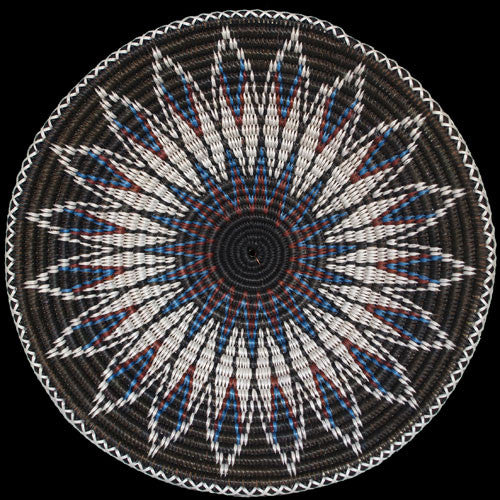
Navajo 19 Feathers Basket - Elsie Holiday (#400)
$1,875.00
Artist: Elsie Holiday
Navajo Basket
14 1/2" x 2" deep
Rounds: 24
It is said that birds of a feather flock together, that people with the same tendencies hang together. Elsie Holiday's baskets have that effect on folks, they want to be near her feather art. Elsie tells us that feathers keep her in constant contact with the higher powers and help her communicate with the Holy People. We feel Elsie's basketry is divinely inspired, so her connectivity must be effective.
We offer a 100% satisfaction guarantee on every purchase.
About the artist:

Considered one of the best Navajo basket weavers, Elsie Stone Holiday married into the famed Douglas Mesa family of weavers. Weaving baskets has become almost an addiction for her. "When I go two or three days without weaving I get anxious to get started again," she says. She weaves 12 hours a day, 5 days a week. "Sometimes I think, 'How long can this last?'", she wistfully states, but for now she is content with her art, finding immense satisfaction in creating premier quality baskets.
Related legends:
Feathers
Feather: As a common denominator the feather figures imortantly in Native American myth, method, and tribal practice. The feather is a metaphor for flight, a messenger to the spirit world. Feathers are used decoratively, as prayer symbols, and as designs of power. Attached to an arrow, the feather becomes the universal emblem of the hunt, of flight, of finding the mark? More about this legend
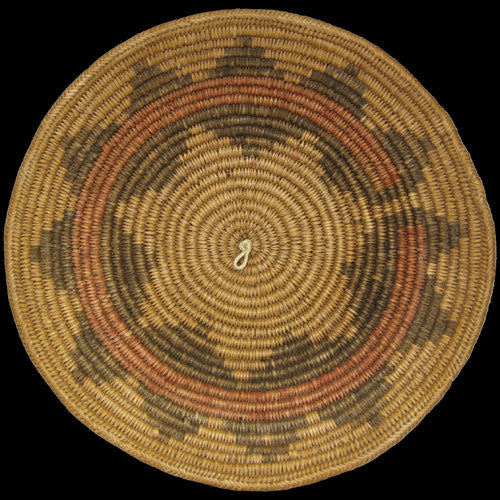
Navajo 1960's Ceremonial Basket (#14)
$850.00
Navajo Baskets
13 3/4" x 2 1/2" deep
Rounds: 22
Classic Navajo wedding baskets have become highly prized and difficult to acquire. At Twin Rocks Trading Post, however, we have located a nice stash of them for distribution to our customers. According to Navajo legend, placing your wealth in these weavings will ensure success and richness. This nice specimen will surely help with the task. Heck, I feel wealthier already.
We offer a 100% satisfaction guarantee on every purchase.
Related legends:
Navajo Ceremonial Baskets
The Navajo wedding basket also reflects many values of traditional life and so often contains all six sacred mountains, including Huerfano and Gobernador Knob, though the size of the basket may determine the numher of mountains in the design. The center spot in the basket represents the beginning of this world, where the Navajo people emerged from a reed? More about this legend
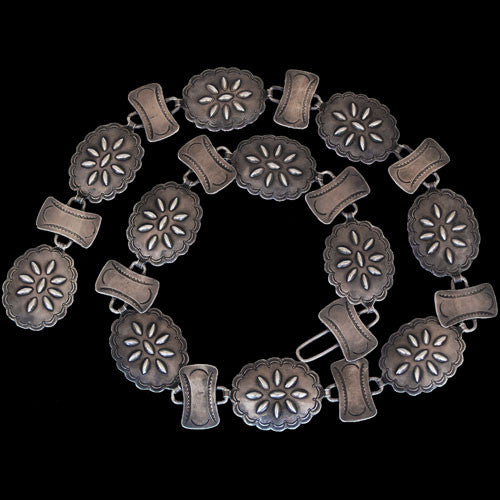
Navajo 1960's Sterling Silver Antiqued Chain Link Concho Belt (#50)
$650.00
Navajo Jewelry
32" long
Patina, experience and years of enjoyment, that’s what this Concho belt from the 1960s says to us. With is folksy style and long use; this belt has had many an interesting time. Get this one on your waste and let the fun begin, again.
We offer a 100% satisfaction guarantee on every purchase.
Related legends:
Silversmith Work
When and how the Navajo acquired the art of working metals is unknown but there are reasons for supposing that it was introduced among them, or at least more developed and improved upon by them, since the time they have occupied their present country?
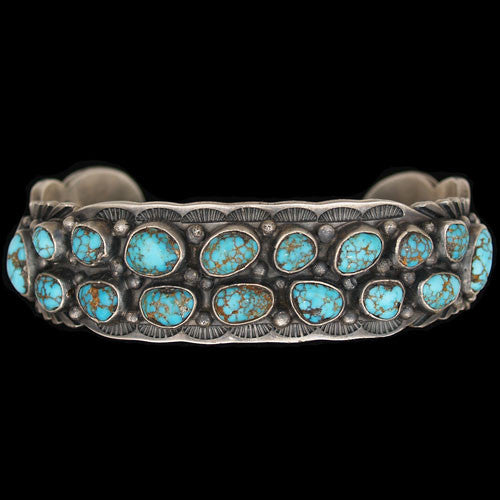
Navajo 1970's Burnham Turquoise 17 Stone Bracelet - Victor Begay (#32)
$1,875.00
Artist: Victor Begay
Navajo Jewelry
Inner Circumference: 5 3/4"
Opening: 1 1/2"
Total: 7 1/4"
Width: 7/8"
Victor Begay of Lukachukai, Arizona sometime in the 1970s, made this bracelet. It was bought by a collector from New York City as a gift for her husband. The bracelet sat in a drawer for nearly 40 years before it was returned to its homeland. We were more than happy to see it. Victor was a prolific artist in that period and produced jewelry of high quality set with top grade turquoise. The stones in this bracelet are from the Burnham mine near Austin, Nevada.
We offer a 100% satisfaction guarantee on every purchase.
Related legends:
Silversmith Work
When and how the Navajo acquired the art of working metals is unknown but there are reasons for supposing that it was introduced among them, or at least more developed and improved upon by them, since the time they have occupied their present country?
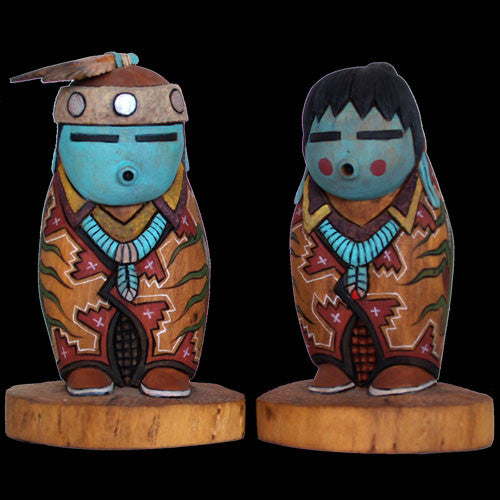
Navajo 2 Piece Creation/Corn Set - Dennis Ross (#58)
$495.00
Artist: Dennis Ross
Folk Art
Largest base: 3 3/4"
Tallest figure: 6 1/2"
Dennis Ross creates people; short, chubby people with a story to tell. In this case, it is a corn family of 2 with husband and wife. These individuals inform us that the first Navajo people were created from corn and that corn remains an important aspect of Navajo life, as a food source, as a cultural staple and as a fertility symbol. Dennis is not afraid to put a lot of detail into his sculptures, and that is apparent from these carvings. Take them home, you will love them forever.
We offer a 100% satisfaction guarantee on every purchase.
About the artist:

Asked how he first started carving, Dennis Ross answers with a laugh, "My brother - he gave me a knife, and a stone, and a piece of carving wood, and said, 'Here you go'." Dennis was twenty-six years old. His brother, Harry Bert, also gave him a little constructive criticism on that first experiment into the creative world of carving, but Dennis took it from there.
Related legends:
Corn in Navajo Traditional Life
The Supernaturals also warn him of taboos connected with the use of corn. It should not be cooked until it is ripe nor eaten before it is fully cooked, or frost and floods will damage the crop. In the "vigil of the corn" ceremony the corn is fed with dried meat; if it were to be fed with corn it would thus consume itself, just as feeding meat to the masks would cause men to eat each other. When giving this warning Talking God refers to the time that ugly woman fed corn to the corn with result that " the people starved and men ate the flesh of other men."?
Dine Emergence/Creation
This is a story told by the Navajo people by word of mouth to the young and old. The Navajo believe there are Five Worlds. We are presently in the fifth world. The first world was a small, dark and water filled world. It was known as the Red World where the flying insects were the first and only people. The second world was blue with the air. The spirit people here were swallows? More about this legend
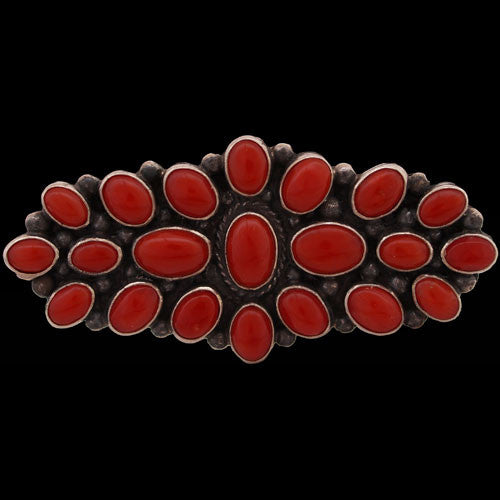
Navajo 21 Coral Stone Brooch/Pendant - Geneva Ramone (#36)
$750.00
Artist: Geneva Ramone
Southwest Jewelry
2 1/2" x 1 1/8"
Coral, beautiful blood red coral, has been the object of desire for Navajo people since the Spanish arrived in the Southwest. Knowing this, Geneva Ramone has taken 21 stones from the deep and combined them into an elegant brooch for any occasion. This well designed and crafted pin is heirloom quality. Navajo people crave coral. You will too.
We offer a 100% satisfaction guarantee on every purchase.
Related legends:
Silversmith Work
When and how the Navajo acquired the art of working metals is unknown but there are reasons for supposing that it was introduced among them, or at least more developed and improved upon by them, since the time they have occupied their present country?
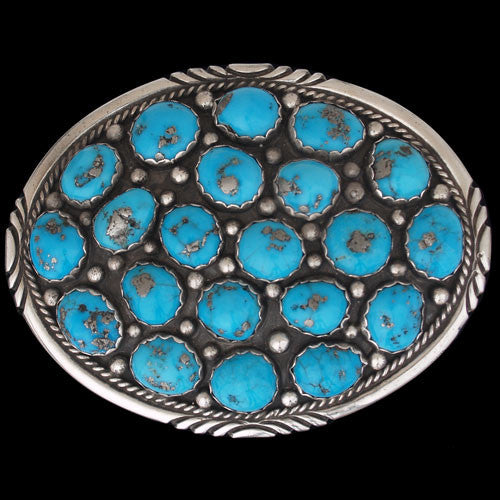
Navajo 21 Stone Sleeping Beauty Turquoise Buckle (#45)
$650.00
Navajo Jewelry
3 1/4" x 2 1/2"
Lucky 21 is what this piece should be called. Made sometime in the 1960s or 1970s, the classically designed belt buckle has twenty-one stunning pieces of deep blue Sleeping Blue turquoise set in a sterling silver mounting. Although the artist’s name has faded from memory, this buckle will capture and hold your attention. Get it on . . . your belt.
We offer a 100% satisfaction guarantee on every purchase.
Sleeping Beauty Turquoise
The Sleeping Beauty turquoise mine is located seven miles from Globe, Arizona. The mine is one of the largest producers of turquoise in North America. The mine, and the turquoise extracted from it, derives its name from Sleeping Beauty Mountain, which at one time was part of the Copper Cities operation. The center of the copper mine is located at approximately 33o24"13.23"N. 110o53'34. 60"W, at an elevation of 1224 feet. Sleeping Beauty Turquoise Mining is presently owned and operated by Monty Nichols.
For many centuries before the first Europeans made their way into Arizona, turquoise was being mined on the slopes of Sleeping Beauty Mountain. The Salado and other ancient peoples mined the beautiful sky stone from several surface outcroppings located in the vicinity, including Pinto Valley. It is believed that Spanish explorers were the first Europeans to locate the source of Sleeping Beauty sometime around the 1860s. By the 1870s, small underground mines pockmarked the hills surrounding present day Globe.
Cities Service Company started the Copper Cities Mine (commonly called the Sleeping Beauty Mine) in 1952 and operated it until the Pinto Valley mine opened in 1972. During the 1960s, L.W. Hardy had the contract to mine turquoise, both at Sleeping Beauty and at Castle Dome, later called the Pinto Valley Mine. Formerly a meat cutter at a market in Miami, Hardy recognized early on that turquoise was more valuable as a gemstone than the associated copper.
By the time the turquoise boom began, Hardy had contracts with mining companies in Miami, Kingman and elsewhere. He also developed a method for stabilizing low-grade, porous turquoise with pressure-impregnated hot acrylic resin, which hardened the stone and improved the color.
Hardy's mining methods were primitive when compared with current operations. Hardy's workers sat in a ditch ripped by a bulldozer and hand picked the stone from waste-rock. Hardy mined turquoise at Sleeping Beauty for 22 years, getting about 45 percent recovery, and leaving the rest in waste dumps.
Monty Nichols received the contract to mine Sleeping Beauty turquoise in 1988, and began using modern mining methods to develop the property. Nichols drills and blasts the overburden, hauling it to the abandoned Copper Cities pit, which now contains the recycled tailings from Miami Copper Company's No. 5 tailing dam. The old dam dominated the eastern skyline of downtown Miami until recently. The year Nichols acquired the contract; he began a two-year project to remove 5,000.000 tons of overburden. Located half way up the side of an open pit mine, the narrow turquoise-bearing zone has about 400 feet of hard waste rock on top of it. In order to move sideways into the ore-body, a whole slice of the mountain had to be removed.
To avoid fracturing the turquoise, Nichols was careful not to blast too near the turquoise-bearing strata. That layer is more crumbly, so the miners can rip it and dump it over screens, separating the material by size. No crushers are used, again to avoid fracturing the gemstone, and the different sized rock is hauled up to a wide mine bench where conveyor belts move the material through three buildings. There, workers handpick turquoise from the broken rock. The buildings are vented with filtered air to eliminate workers' exposure to dust, and well insulated to keep them comfortable in any weather. It is a far cry from the old methods of mining. Anywhere from 30 to 40 people work at the mine at any one time, depending on how much mining there is to do.
Fifty years ago, mine workers filled lunch buckets with the colorful rock, even though it was reason for immediate termination. Old habits die hard, and some people still think it is okay to sneak in and try to pick turquoise. As a result, security is tight in and around the mine. Motion detectors, night vision cameras and 24/7 roving patrols are used, so the only turquoise leaving the property now is being shipped to markets around the world.
Italy is the largest volume buyer of Sleeping Beauty turquoise, with Germany and Hong Kong following closely behind. These customers buy the best grade for their exclusive jewelry. Jewelry makers in India and Spain also receive Sleeping Beauty turquoise, while in the U.S., Gallup and Albuquerque are the largest consumers.
The Sleeping Beauty turquoise mine produces a uniform light to medium blue turquoise with rare finds of deep, dark blue. Because of its uniformity, it has been a favorite of the Zuni Pueblo. Zuni silversmiths often use it in channel inlay and various types of cluster work that require large numbers of small, perfectly matched stones. The Sleeping Beauty mine has been one of the larger producers of rough turquoise in the United States, although today much less good turquoise is being produced than in the past.
Sleeping Beauty turquoise is noted for its solid, light blue color with no matrix; the host rock is usually granite. Nichols says the mine is producing about 1,600 pounds a month. Of that, only four percent is natural; most of the turquoise from the mine is altered in some way. Most is enhanced, which is more expensive than stabilization, and sold to large distributors in this country and Europe. Currently most of the turquoise that comes from the mine is from the tons of tailings piles that have been accumulating for decades.
The best of the Sleeping Beauty turquoise is comparable to that found in the Middle East. It is thought that large quantities of Sleeping Beauty turquoise is taken overseas and smuggled into, then out of, Iran to be sold as “Persian” turquoise.
Related legends:
Silversmith Work
When and how the Navajo acquired the art of working metals is unknown but there are reasons for supposing that it was introduced among them, or at least more developed and improved upon by them, since the time they have occupied their present country?
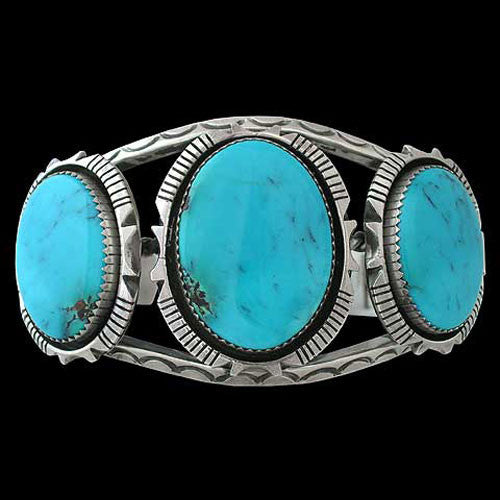
Navajo 3 Stone Blue Diamond Turquoise Bracelet - Toby Henderson (#048)
$950.00
Artist: Toby Henderson
Navajo Jewelry
Inner Circumference: 5 3/4"
Opening: 1"
Total: 6 3/4"
Width: 1 1/2"
From high upon a mountaintop in central Nevada comes this sky blue turquoise with the name of Blue Diamond. The Blue Diamond mine has the ability of producing a super high grade of natural turquoise and this bracelet possesses just that. Toby Henderson has a passion for top-notch turquoise and loves to set it in traditional styles of Navajo jewelry. Toby's hand stamped, carved and formed sterling silver setting beautifully accentuates the amazing nature of this turquoise. "Shazam!"
We offer a 100% satisfaction guarantee on every purchase.
About the artist:

Toby Henderson was born and raised in Phoenix, Arizona. The roots of his family tree are buried deep in the Borrego Pass area of the Navajo Reservation in New Mexico. Toby's mother Ella Long, his grandparents, Helen and Jim Long, and his Uncle Phillip Long, and Tommy Long are all silver and gold smiths recognized for high quality and innovative workmanship. Toby learned his art from his grandparents with whom he spent the summer months when he was a young boy. Toby recalls that his Grandparents were patient and inspiring instructors. They were pleased that he was carrying on the family silversmith tradition. Toby's work can be described as both traditional and contemporary, he has a special fondness for hand crafted, three-dimensional, sterling silver kachinas and Yei-be-chei figures. Toby was the first in his family to create these freestanding Holy People figures. With his daughters and son Toby keeps the family tradition alive. The boy and girls help with everything from design to buffing and polishing.
Related legends:
Silversmith Work
When and how the Navajo acquired the art of working metals is unknown but there are reasons for supposing that it was introduced among them, or at least more developed and improved upon by them, since the time they have occupied their present country?
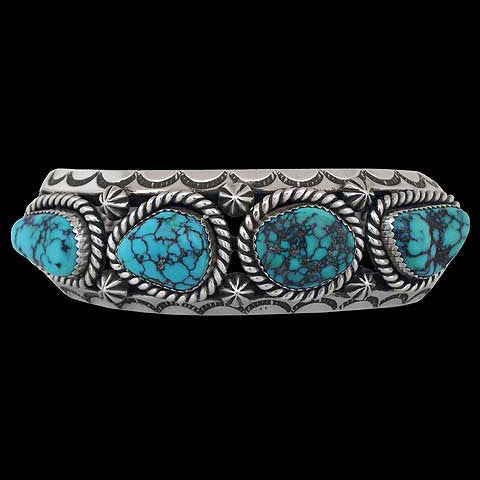
Navajo 4 Stone Turquoise Bracelet - Toby Henderson (#062)
$1,625.00
Artist: Toby Henderson
Navajo Jewelry
Hand Stamped Sterling Silver Bracelet
set with Natural Godber Turquoise and
Natural Burnham Turquoise
Size - 7 1/8
Inner Circumference - 6 1/8"
Opening - 1"
We offer a 100% satisfaction guarantee on every purchase.
About the artist:

Toby Henderson was born and raised in Phoenix, Arizona. The roots of his family tree are buried deep in the Borrego Pass area of the Navajo Reservation in New Mexico. Toby's mother Ella Long, his grandparents, Helen and Jim Long, and his Uncle Phillip Long, and Tommy Long are all silver and gold smiths recognized for high quality and innovative workmanship. Toby learned his art from his grandparents with whom he spent the summer months when he was a young boy. Toby recalls that his Grandparents were patient and inspiring instructors. They were pleased that he was carrying on the family silversmith tradition. Toby's work can be described as both traditional and contemporary, he has a special fondness for hand crafted, three-dimensional, sterling silver kachinas and Yei-be-chei figures. Toby was the first in his family to create these freestanding Holy People figures. With his daughters and son Toby keeps the family tradition alive. The boy and girls help with everything from design to buffing and polishing.
Related legends:
Silversmith Work
When and how the Navajo acquired the art of working metals is unknown but there are reasons for supposing that it was introduced among them, or at least more developed and improved upon by them, since the time they have occupied their present country?
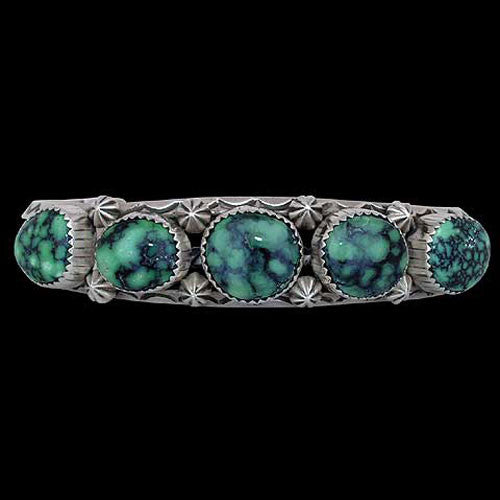
Navajo 5 Stone Candelaria Variscite Bracelet - Toby Henderson #068
$690.00
Artist: Toby Henderson
Navajo Jewelry
Hand Stamped Sterling Silver Bracelet set with 5 Candelaria Variscite Stones
Size - 7
Inner Circumference - 5 5/8"
Opening - 1 3/8"
Veriscite is a copper mineral, a close cousin to turquoise, and, like the stones set in this bracelet, can be exceptionally beautiful. The wintergreen color of this Candelaria Veriscite, which is contrasted by wispy black matrix, is eye-poppingly attractive. Navajo silversmith Toby Henderson displays these natural, gem-grade stones in this classic, old-style, hand-wrought cuff. Owning this bracelet is sure to make other collector's green with envy.
We offer a 100% satisfaction guarantee on every purchase.
The Columbus/Candelaria turquoise mining district is centered around the ghost town of Candelaria, Nevada. Located in the west-central part of the state, Esmerelda County, the district is just 45 miles northeast of Tonopah, on US Highway 95. To be even more specific, the claims are generally located in a heavily worked open pit copper, silver and gold mine bordering the town. Map coordinates are: 38 degrees 09'26.00"N 118 degrees 05'13.00W, at 5,800 feet elevation.
The Candelaria mine dates to the mid-1800s, when the Spanish first mined it for turquoise and variscite. Mining operations were recognizably established around Candelaria in1863, and were worked heavily in the 1870's. The town of Candelaria was founded in 1865, and in the 1980's and 90's the mine was largely expanded in search of precious metals.
Today the mining company that owns the property infrequently leases claims to a few diligent miners. Many areas in the pit are dangerously inaccessible due to erosion and weathering, making Candelaria turquoise all the more rare. Small outlying claims are also mined on a sporadic basis. Candelaria turquoise is usually found in veins, seams and rarely as clam pseudomorphs.
The Candelaria turquoise that can be found on today's market is generally of good commercial quality to gem grade. Colors range from medium to high, "electric", blue saturation. Candelaria turquoise can be pure, almost translucent, blue in color, similar to classic Blue Gem turquoise. The matrix patterns found in Candelaria turquoise are extremely varied, showing everything from birds-eye patterns, to knots with intermittent black to brown matrix. Spider web matrix is highly unusual in Candelaria turquoise, but has been known to exist. Material from this area is typically very hard.
The Candelaria region is probably best known for producing a beautifully attractive variscite, which comes in a wide spectrum of colors; again rarely found with spiderweb matrix. Candelaria variscite is generally very hard, with a high silica content.
About the artist:

Toby Henderson was born and raised in Phoenix, Arizona. The roots of his family tree are buried deep in the Borrego Pass area of the Navajo Reservation in New Mexico. Toby's mother Ella Long, his grandparents, Helen and Jim Long, and his Uncle Phillip Long, and Tommy Long are all silver and gold smiths recognized for high quality and innovative workmanship. Toby learned his art from his grandparents with whom he spent the summer months when he was a young boy. Toby recalls that his Grandparents were patient and inspiring instructors. They were pleased that he was carrying on the family silversmith tradition. Toby's work can be described as both traditional and contemporary, he has a special fondness for hand crafted, three-dimensional, sterling silver kachinas and Yei-be-chei figures. Toby was the first in his family to create these freestanding Holy People figures. With his daughters and son Toby keeps the family tradition alive. The boy and girls help with everything from design to buffing and polishing.
Related legends:
Silversmith Work
When and how the Navajo acquired the art of working metals is unknown but there are reasons for supposing that it was introduced among them, or at least more developed and improved upon by them, since the time they have occupied their present country?
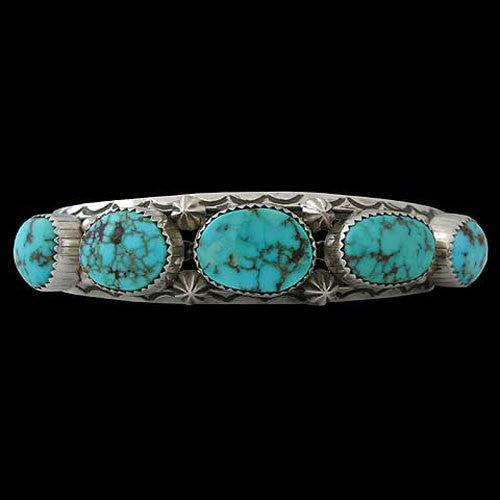
Navajo 5 Stone Godber Turquoise Bracelet - Toby Henderson (#039)
$750.00
Artist: Toby Henderson
Navajo Jewelry
Inner Circumference: 5 3/4"
Opening: 1 1/4"
Total: 7"
Width: 3/4"
The Godber, Burnham and Dry Creek mines are one and the same. It is located thirty miles east of Austin, Nevada on a hilltop resting within the boundaries of the Damele Ranch and within sight of the old Pony Express Trail. Bruce Woods owns the patented claim and mines the turquoise on an irregular basis. The natural turquoise in this bracelet is some of the harder and higher blue stone that has come from this mine. Toby has hand hammered and shaped this bracelet of sterling silver giving it an old style, traditional look. Five matching pieces of terrific turquoise in a row--now that is an extremely lucky find.
We offer a 100% satisfaction guarantee on every purchase.
About the artist:

Toby Henderson was born and raised in Phoenix, Arizona. The roots of his family tree are buried deep in the Borrego Pass area of the Navajo Reservation in New Mexico. Toby's mother Ella Long, his grandparents, Helen and Jim Long, and his Uncle Phillip Long, and Tommy Long are all silver and gold smiths recognized for high quality and innovative workmanship. Toby learned his art from his grandparents with whom he spent the summer months when he was a young boy. Toby recalls that his Grandparents were patient and inspiring instructors. They were pleased that he was carrying on the family silversmith tradition. Toby's work can be described as both traditional and contemporary, he has a special fondness for hand crafted, three-dimensional, sterling silver kachinas and Yei-be-chei figures. Toby was the first in his family to create these freestanding Holy People figures. With his daughters and son Toby keeps the family tradition alive. The boy and girls help with everything from design to buffing and polishing.
Related legends:
Silversmith Work
When and how the Navajo acquired the art of working metals is unknown but there are reasons for supposing that it was introduced among them, or at least more developed and improved upon by them, since the time they have occupied their present country?
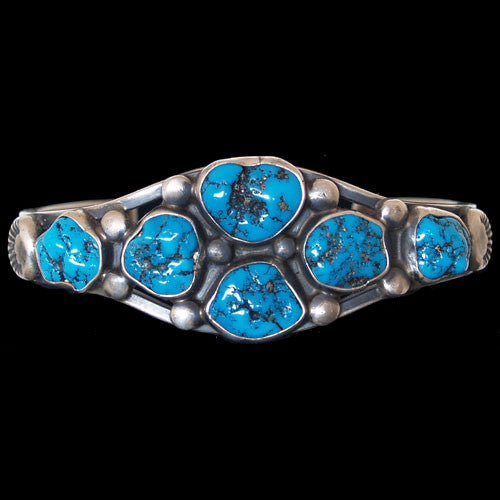
Navajo 6 High Grade Natural Kingman Turquoise Bracelet - Verdy Jake (#43)
$350.00
Artist: Verdy Jake
Total inner circumference including
opening: 6 1/4" Opening: 1 1/8"
Verde Jake is a Navajo silversmith who, quite simply, loves to work in the more classic styles, using techniques her grandfather taught her. She prefers the clean and simple lines of traditional Navajo jewelry and attempts to spotlight the unique nature of the turquoise she is setting. The high-grade natural Kingman turquoise in this bracelet relates beautifully to Verdy's style of silver work.
Kingman Turquoise
Kingman Turquoise comes from a large open-pit copper mine in the Mineral Park Mining District, northwest of Kingman, Arizona and was one of the largest turquoise mines in this country. The area lies in high desert country at an elevation of 3,345 feet and is surrounded by three mountain ranges. The mining district around Kingman, Arizona has always been a large producer of turquoise, at one time the world's largest. First mined by Indians, this area was home to the most extensive prehistoric workings found in Arizona.
The modern production of turquoise dates back to the early 1880’s when James Haas rediscovered these ancient Kingman area mines. Much of the turquoise occurred as seams, masses and veins. The color of natural Kingman turquoise can range from light blue to very dark blue and sometimes tints of green. The matrix is from white, light brown to black and frequently flecked with pyrite and times quartz. The mine became famous for its rounded, bright blue nuggets with black matrix. Few turquoise mines produced nuggets, especially of this quality. In its high-grade form it has always been considered among the top quality American turquoise. With so many thousands of pounds of good quality turquoise produced in the Kingman area over the last one hundred years it is hard to believe that today very little high-grade Kingman turquoise is available.
Other names for Kingman turquoise: Ithaca Peak, The Wall, Tiffany, Courtland, Az., Gleeson
Most desirable: Deep Blue with molybdenum pyrite; Real blue with pyrite; Bird's eye; Water Web; Nuggets
About the artist:
The jewelry created by Navajo silversmith Verdy Jake reflects Southwest jewelry classicism at its best. Showcasing high quality turquoise and coral with substantial silver work, she intuits a perfect balance between precious metal and precious stone.
Related legends:
Silversmith Work
When and how the Navajo acquired the art of working metals is unknown but there are reasons for supposing that it was introduced among them, or at least more developed and improved upon by them, since the time they have occupied their present country?
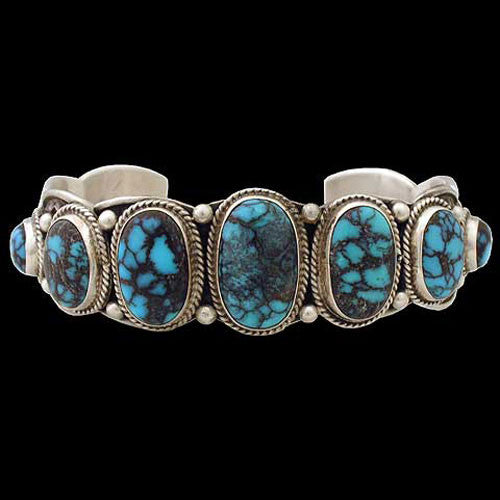
Navajo 7 High Grade Natural Chinese Turquoise Bracelet - Benjamin Piasso (#04)
$775.00
Artist: Benjamin Piasso
Navajo Jewelry
Size - 6 7/8
Total Circumference: 6 3/4"
Inner Circumference: 5 3/4"
Opening: 1"
Largest Stone: 3/4" tall x 1/2" wide
The turquoise in this bracelet is some of the highest quality to have ever crossed the threshold of Twin Rocks trading post. The depth of color, matrix appeal, hardness and shine are par excellence or as the old miners say; "That stuff has ZAT!" Benjamin Piasso has done an excellent job of setting this gorgeous suite of natural, gemmy turquoise stones in a classic Navajo setting. His work is "Spot On!"
We offer a 100% satisfaction guarantee on every purchase.
Related legends:
Silversmith Work
When and how the Navajo acquired the art of working metals is unknown but there are reasons for supposing that it was introduced among them, or at least more developed and improved upon by them, since the time they have occupied their present country?
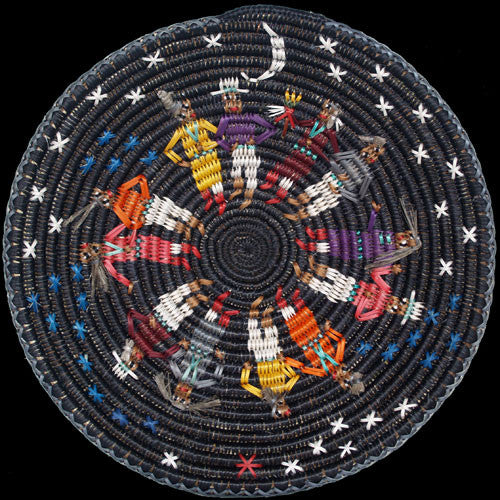
Navajo After Midnight Basket - Lorraine Black (#250)
$750.00
Artist: Lorraine Black
12 1/2" x 1 1/4" deep
Rounds: 23
About the artist:

Inspired by dreams, Lorraine Black's skills have literally elevated basket weaving to new dimensions. Lorraine Black's infectious laugh belies the serious magic her hands conjure up when weaving a basket. Unprecedented in her ideas, Lorraine's baskets are innovative and beautiful. Many of them make good use of texture through over-stitching and the addition of objects such as flint arrowheads or horsehair.
Related legends:
War/Squaw Dance
he so called war dance, extensively in vogue with the Navaho today, originated with the mother of the Slayer of Monsters and the Child of Water. For, it is said, when they had slain the monster yeitso, they carried his scalp as a trophy and hung it on a tree previous to reporting to their mother. While relating to her of the encounter with the monster they swooned and lay unconscious, whereupon, it is said, their mother prepared a concoction from herbs struck by lightning, sprinkled them with it, and shot a spruce and pine arrow over their bodies, thus reviving them? More about this legend
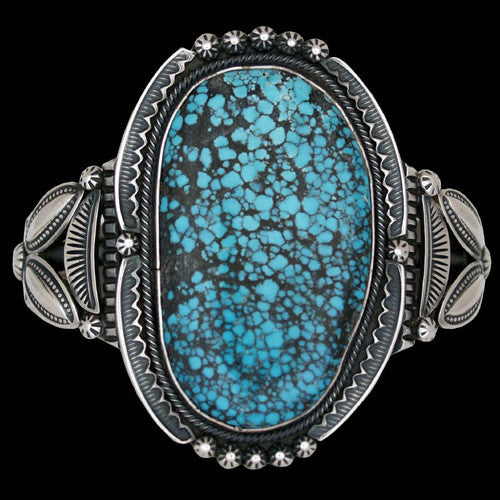
Navajo Antiqued Silver & Chinese Turquoise Bracelet - P.J. Begay (#05)
$450.00
Artist: P.J. Begay
Navajo Turquoise Jewelry
Handmade Sterling Silver Antiqued Bracelet set with Natural Chinese Turquoise
Size - 7 1/2
Inner Circumference - 5 3/4"
Opening - 1 3/4"
Stone - 2" tall x 1 1/4" wide
We offer a 100% satisfaction guarantee on every purchase.
Heavy, hand-formed jewelry of substantial quality is typical of Paul (P.J.) Begay's work. Beginning with over-sized sterling silver half-round wire and sheet, Paul fashions and crafts an enduring wrist ornament that will endure the test of time. Simply put, you will not wear this bracelet out in one life; reincarnation will be necessary. Paul has chosen a beautiful cabochon of natural spider-web Chinese turquoise to incorporate into his silver work. With hardened steel stamps, Paul impresses leaves, scallops and hogan beads upon malleable, antiqued metal. This is the type of work one might find upon the weathered, leathery wrist of a traditional Navajo wandering the canyons and mesas of Dinetah.
Related legends:
Silversmith Work
When and how the Navajo acquired the art of working metals is unknown but there are reasons for supposing that it was introduced among them, or at least more developed and improved upon by them, since the time they have occupied their present country?
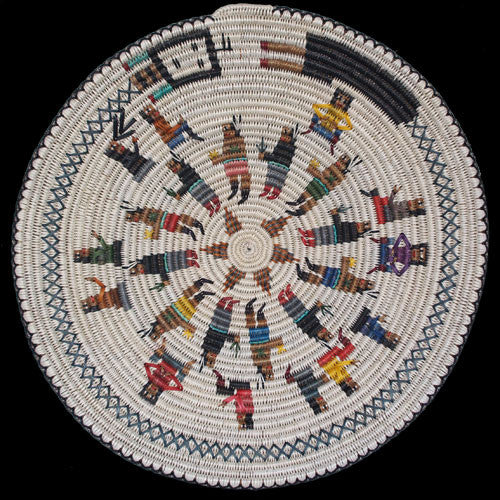
Navajo At the Sing Basket - Lorraine Black (#251)
$2,500.00
Artist: Lorraine Black
18 3/8" x 2 1/2" deep
Rounds: 33
"At the sing," is a representation of the Mountain Chant ceremony practiced by Navajo people. It is a traditional ceremonial activity based on purging negativity from the body and mind. The dance is conducted inside a green circle of branches embraced by the Holy People. Participants sing and sway around a large, hot fire. The Mountain Chant is one of the few remaining ceremonies still being practiced in Navajo-land and it is taken seriously. Lorraine Black is an excellent weaver, and this basket is an exceptional example of her highly developed skill set.
About the artist:

Inspired by dreams, Lorraine Black's skills have literally elevated basket weaving to new dimensions. Lorraine Black's infectious laugh belies the serious magic her hands conjure up when weaving a basket. Unprecedented in her ideas, Lorraine's baskets are innovative and beautiful. Many of them make good use of texture through over-stitching and the addition of objects such as flint arrowheads or horsehair.
Related legends:
Tsilkehji - Mountain Chant
There were twelve men and two women belonging to one family called N'Dohtet-leh and whose home was at Taylin (Horse Lake in the Apache country); they rode on sun dogs killing the cave dwellers in that region while the two women stayed at Taylin. Early one morning they came to Kintyel near Kayenta and found the cave dwellers holding the Eagle ceremony, and the N'Dohtet-leh killed all the Eagle dancers? More about this legend

Navajo Bearer of the Sun Carving - Robin Wellito (#09)
$875.00
Artist: Robin Wellito
Navajo Folk Art
8 1/2" x 42"
We offer a 100% satisfaction guarantee on every purchase.
About the artist:

Related legends:
Sun
The morning after their arrival the sun rises as a red glare indicating danger. Pg. 206, Flint Way.
The attack proceeds, and they fight even in the village. Two of Sun's children are killed, and Sun rises red and trembling until the perfect shell discs in which they were dressed are recovered for him? More about this legend
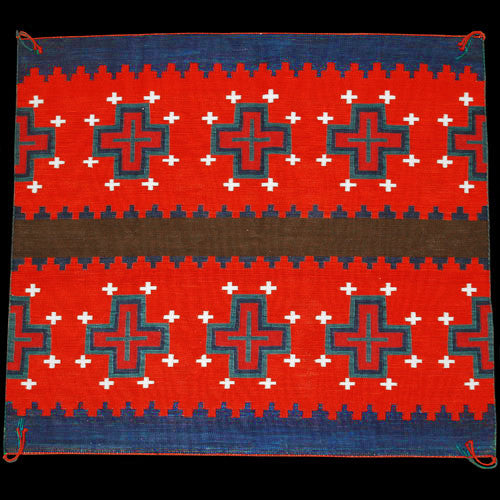
Navajo Biil Dress Weaving - Nellie Dean (#02)
$4,375.00
Artist: Nellie Dean
Navajo Rugs
48" x 55"
Navajo weaver Nellie Dean, of Cove, Arizona wove this marvelous woman's manta. The design replicates a classic period of Navajo woman dress patterns with Puebloan influence. The natural indigo and cochineal colors are hand-dyed, as are the aniline colors. The white is completely natural. The warp and weft wool is from the Churro sheep.
We offer a 100% satisfaction guarantee on every purchase.
About the artist:

Related legends:
Weaving
After the medicine woman told the people about the prayersticks she told them that there was a place in the underworld where two rivers crossed. It was called ni tqin'kae tsosi, fine fiber cotton (Indian hemp). There were two persons who brought the seed of that plant, they were spiders. They said that the people were to use the plant instead of skins for their clothing. So this seed was planted in the earth? More about this legend
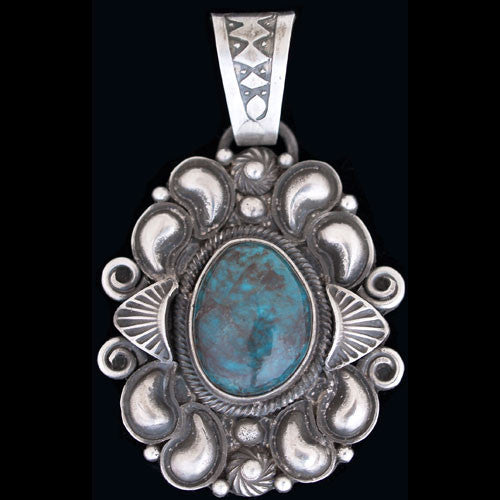
Navajo Bisbee Turquoise Pendant - Derrick Gordon (#22)
$525.00
Artist: Derrick Gordon
Navajo Jewelry
1 1/4" x 2 1/8"
We have had this cabochon of high grade natural Smoky Bisbee put away since the mid-1980s, just waiting for the right artist to set it. As it turns out, Navajo artist Derrick Gordon was just the man for the job. Derrick placed the stone in an old style "Bumped Out" setting that presents it perfectly. This pendent represents the workmanship of a top artist and features an excellent piece of high-end Bisbee turquoise.
We offer a 100% satisfaction guarantee on every purchase.
Bisbee Turquoise
Bisbee turquoise jewelry is highly coveted by collectors worldwide. The signature look for Bisbee turquoise is a dark lavender blue color with a deep chocolate brown to black matrix. Some of the most distinctively recognizable Indian jewelry has been set and photographed containing classic Bisbee turquoise. As with all turquoise, there is a wide variety of quality from the Bisbee mine where color and matrix patterns can vary a great deal.
The most productive period of the Bisbee turquoise mine was the 1950's and 1960's. The mine has been closed since the early 1970's and is currently owned by Phelps Dodge Corp. Bisbee Mine. Arizona, Cochise County. Turquoise is a copper compound and, in the case of the Bisbee mine, is found in the open pit copper mine known as the Lavender Pit. At this mine, it is typically found as stringers up to a few inches wide; as small nugget-like masses in granite and quartzite; or as minute stringers in massive pyrite.
About the artist:
At the age of nineteen, Derrick Gordon sat down at the bench with his uncle, Delbert Gordon, and a promising new career was launched. Derrick was born and raised in Gallup, New Mexico. He came into this world in 1971, but it was not until 1990 that he began to bless us with his unique style of Navajo silver jewelry.
Related legends:
Silversmith Work
When and how the Navajo acquired the art of working metals is unknown but there are reasons for supposing that it was introduced among them, or at least more developed and improved upon by them, since the time they have occupied their present country?
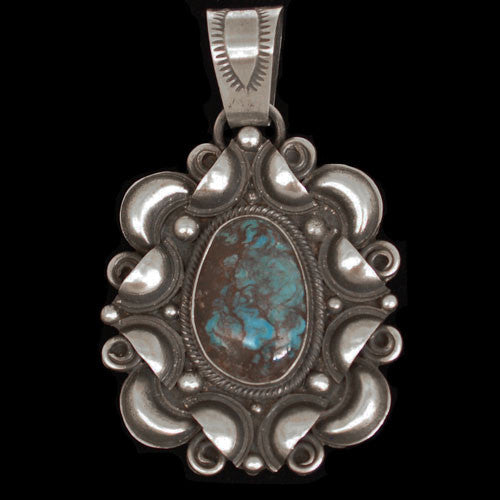
Navajo Bisbee Turquoise Pendent - Derrick Gordon (#21)
$570.00
Artist: Derrick Gordon
ATC
Navajo Jewelry
1 1/2" x 2 1/4"
Smokey Bisbee is some of the most sought-after turquoise in the world, and Derrick Gordon has found a piece to set in this skillfully designed and built pendant. You will be happy to let this smoke get in your eyes.
We offer a 100% satisfaction guarantee on every purchase.
Bisbee Turquoise
Bisbee turquoise jewelry is highly coveted by collectors worldwide. The signature look for Bisbee turquoise is a dark lavender blue color with a deep chocolate brown to black matrix. Some of the most distinctively recognizable Indian jewelry has been set and photographed containing classic Bisbee turquoise. As with all turquoise, there is a wide variety of quality from the Bisbee mine where color and matrix patterns can vary a great deal.
The most productive period of the Bisbee turquoise mine was the 1950's and 1960's. The mine has been closed since the early 1970's and is currently owned by Phelps Dodge Corp. Bisbee Mine. Arizona, Cochise County. Turquoise is a copper compound and, in the case of the Bisbee mine, is found in the open pit copper mine known as the Lavender Pit. At this mine, it is typically found as stringers up to a few inches wide; as small nugget-like masses in granite and quartzite; or as minute stringers in massive pyrite.
About the artist:
At the age of nineteen, Derrick Gordon sat down at the bench with his uncle, Delbert Gordon, and a promising new career was launched. Derrick was born and raised in Gallup, New Mexico. He came into this world in 1971, but it was not until 1990 that he began to bless us with his unique style of Navajo silver jewelry.
Related legends:
Precious Stones
Turquoise; Precious stones have symbolic implications. For example, turquoise if a "collective term for all the precious stones, wealth, or mixed offerings. Good fortune is attributed to this stone." Both white shell and turquoise are emphasized in Kinaalda? More about this legend
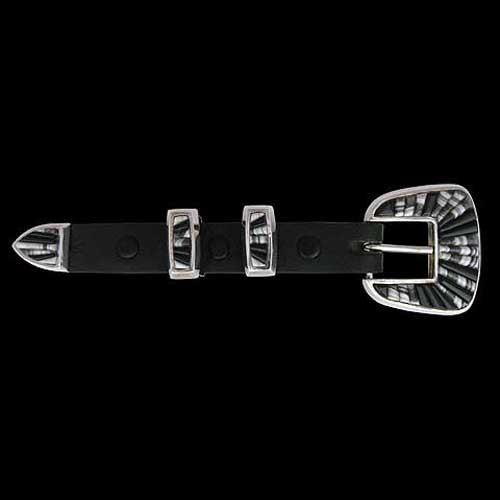
Navajo Black Jade & Agate Ranger Buckle - Tommy Jackson (#018)
$540.00
Artist: Tommy Jackson
Navajo Jewelry
Sterling Silver Ranger Buckle set with Black Jade and Agate
Total Length: 6 3/4"
Belt Width: 3/4"
We offer a 100% satisfaction guarantee on every purchase.
About the artist:

Related legends:
Silversmith Work
When and how the Navajo acquired the art of working metals is unknown but there are reasons for supposing that it was introduced among them, or at least more developed and improved upon by them, since the time they have occupied their present country?
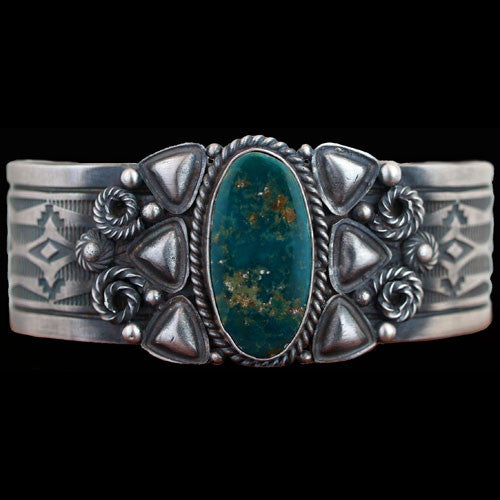
Navajo Blue Gem Turquoise Bracelet - Derrick Gordon (#14)
$800.00
Artist: Derrick Gordon
ATC
Navajo Jewelry
Total Circumference: 6 1/8"
Inner Circumference: 5"
Opening: 1 1/8"
This heavily embossed, sterling silver bracelet with it's high grade, natural cabochon of Blue Gem turquoise and accompanying accents is a wonderful example of old style Navajo silver work. Derrick Gordon is a master craftsman when it comes to creative silver work and the turquoise he set's his jewelry with is over the top in quality. Blue gem turquoise was once mined near the Battle Mountain region of Nevada but the mine is no longer there. A major corporation, in search of precious metals excavated and processed the entire mountain. This makes Derrick's bracelet all the more valued and treasured.
We offer a 100% satisfaction guarantee on every purchase.
Blue Gem Turquoise
Blue Gem turquoise occurs in argillized quartz monzonite cut by two limonite-stained sheer zones, one trending N 35 o W and dipping 75 o NE, the other trending N, 25 o E and dipping 55 o NW. An extensive breccia zone about 10 feet wide is developed between the two bounding sheers. Exceptionally good quality turquoise forms veins up to three-quarters of an inch thick along the shears. Pyrite-bearing quartz veins are closely associated with the turquoise.
The Blue Gem mine was at one time located deep underground, accessed by tunnels as deep as 800 feet. This is of interest because the Blue Gem Mine and the Bisbee Mine in Arizona are the only two mines (of which we are aware) that turquoise was found that deep in the earth. The Blue Gem mine was once developed in extensive underground workings and open stoops. An audit several hundred feet long on the main structure connected to numerous shorter tunnels and several open stoops. Directly above the main audit was a glory hole some 100 feet long.
Duke Goff first noted the Blue Gem deposit in 1934. It was subsequently leased from the Copper Canyon Mining Co. by the American Gem Co. of San Gabriel, CA., owned by Doc Wilson and his sons, Del and William. The company operated the property until 1941 when the outbreak of the war caused a shortage of experienced miners. Both Del and William Wilson were called into the Army for the duration of the war, and this compelled the closing of the mine. Consequently, the lease was allowed to lapse and work was abandoned. In 1950 Lee Hand and Alvin Layton of Battle Mountain leased the mine.
Production of turquoise at the Blue Gem lease in the early days of the operation was enormous. Although there is no exact information, it is reported that the output amounted to nearly
$1 million in rough turquoise. The mine is still active, although Duval Corp is currently in the center of a major copper deposit developing it.
Pyrite in Blue Gem is unusual to see but not unheard of. Very little large material ever came out of Blue Gem, the majority found was small 1-mm "bleeder" veins and tiny nuggets which was perfect for Zuni inlay and fine needlepoint, petit-point and snake-eyes jewelry. Blue Gem turquoise was very popular in the late 1930's and 40's and was commonly used in the Fred Harvey "tourist jewelry" that is so collectable today. Blue Gem turquoise is extremely hard and stands up well to the test of time.
Blue Gem turquoise is a rare, valuable and historic American treasure. Quality Blue Gem Turquoise has been gifted with a wide range and variety of color. Because Blue Gem turquoise is very hard, a high polish is associated with this stone, and unlike most turquoise, won't easily change color. This turquoise has a unique character and many different looks all of which are striking, full of wonder and pleasing to the eye.
Production of the mine started about 1934 and continued into the 1970's. Blue Gem Turquoise is still some of the finest turquoise ever found, and unlike most turquoise mines, (in which the majority mined is chalky and only usable if stabilized) most of the turquoise found there was of gem-quality. Today the Blue Gem mine is not viable; it sits in the middle of a huge mining operation. The emphasis is on precious metals and the extraction of turquoise is considered more of a hindrance in the mining process rather than an asset. Even the ever-popular "Dump Diving" for turquoise through the overburden is not tolerated due to the very real danger of becoming buried in a slide. Insurance factors, equipment hazards, high explosives and safety issues along with a lack of interest from the mining company keep Blue Gem turquoise unavailable to the world, at least for now.
About the artist:
At the age of nineteen, Derrick Gordon sat down at the bench with his uncle, Delbert Gordon, and a promising new career was launched. Derrick was born and raised in Gallup, New Mexico. He came into this world in 1971, but it was not until 1990 that he began to bless us with his unique style of Navajo silver jewelry.
Related legends:
Silversmith Work
When and how the Navajo acquired the art of working metals is unknown but there are reasons for supposing that it was introduced among them, or at least more developed and improved upon by them, since the time they have occupied their present country?
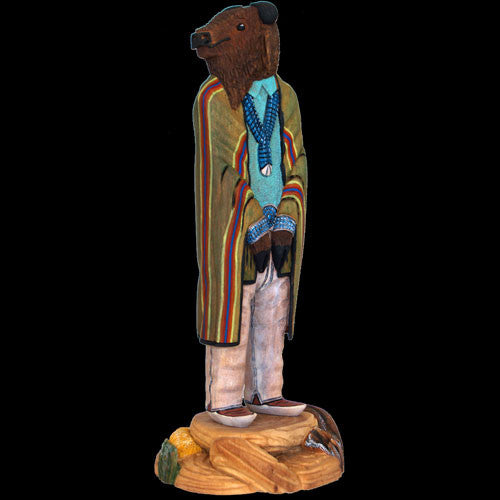
Navajo Buffalo Cottonwood Root Carving - Marvin Jim (#370)
$750.00
Artist: Marvin Jim
Base: 7" x 7 1/4" Height: 17"
Native Americans revere the bison. No matter whether they are Navajo, Paiute or any other tribe, bison carry a lot of weight in Native cultures. So, it is no surprise Marvin Jim has chosen this animal for his latest sculpture. With precise carving and careful painting, Marvin has brought to life another cultural icon.
About the artist:

Marvin Jim - Animal Sculptures:
Based upon the Navajo creation tales, the sculptures of Marvin Jim reflect a time long ago, when animals and humans walked and worked together to create a new world. These traditional stories speak of conversations among all beings, of behaving in a manner of mutual respect and of all beings having an equal position in the community. These legends are an essential part of the Navajo culture. The tales are of universal interaction, compassion and tolerance; the things necessary to live a balanced existence.
Related legends:
Buffalo People in Navajo Mythology
The day after the last ceremony was over Holy Man started out on another hunting trip. He went toward San Francisco Mountains on top of which there is a lake called Crescent lake. From this place he saw what he thought were four mountain sheep. He was afraid of them, remembering his experience on Black Mountain when Thunder captured him. He made a detour of the lake to to get a closer view, but now the animals were on the opposite side. Four times this happened. The fourth time he was able to see that they were buffalo, one black, one white, one blue and one yellow?
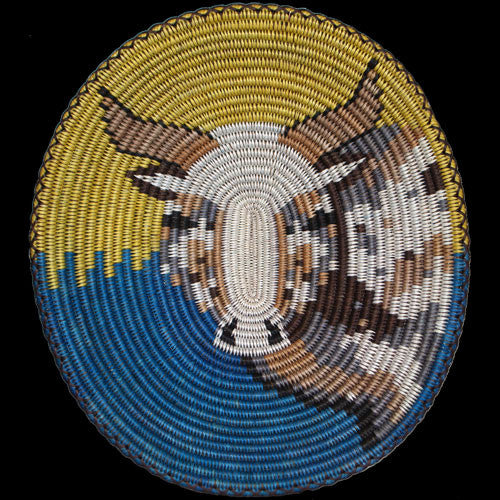
Navajo Bull Too Basket - Elsie Holiday (#402)
$3,250.00
Artist: Elsie Holiday
Navajo Basket
16" x 18" x 2 1/2" deep
Rounds: 26
No bull, this “Bull Too” basket by Elsie Holiday is a wonderment. Abstract in terms of design and color, this weaving stands as a testament to Elsie’s amazing talent. Hallelujah brother, we believe she is the very best!
We offer a 100% satisfaction guarantee on every purchase.
About the artist:

Considered one of the best Navajo basket weavers, Elsie Stone Holiday married into the famed Douglas Mesa family of weavers. Weaving baskets has become almost an addiction for her. "When I go two or three days without weaving I get anxious to get started again," she says. She weaves 12 hours a day, 5 days a week. "Sometimes I think, 'How long can this last?'", she wistfully states, but for now she is content with her art, finding immense satisfaction in creating premier quality baskets.
Related legends:
Property
Among the explanatory elements already cited, two concern property or material possessions the prescription of the marriage payment and the belief that earth people would quarrel over sandpaintings. The possession of property is used as a standard of comparison in a reference to Apache aliens; The fact that Navajo runners win valuables from them is given as the reason why the Navajo have ever since been richer than their neighbors. These references indicate the importance attributed to the possession of property, particularly as it is useful for sexual and ritual purposes? More about this legend
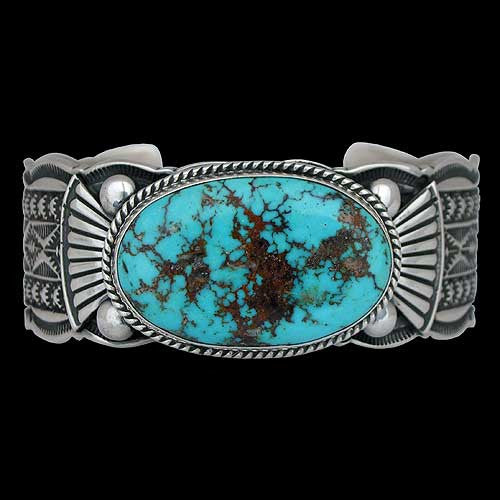
Navajo Burnham Turquoise Bracelet - Guy Haskie (#018)
$1,220.00
Artist: Guy Haskie
Navajo Jewelry
Hand Stamped Sterling Silver Cuff Bracelet set with Natural, Gem Grade Burnham Turquoise
Size - 6 5/8
Inner Circumference - 5 5/8"
Opening - 1"
Like the intricate pattern of a diamondback rattlesnake, the design on this Guy Haskie bracelet is mesmerizing. Intricate stamping sets off a beautiful and large natural, gem grade Burnham turquoise stone. Guy is well known for his silver smithing talents and has used them to great effect in this stunning cuff. This is a piece that will make any turquoise jewelry lover happy.
We offer a 100% satisfaction guarantee on every purchase.
Related legends:
Silversmith Work
When and how the Navajo acquired the art of working metals is unknown but there are reasons for supposing that it was introduced among them, or at least more developed and improved upon by them, since the time they have occupied their present country?
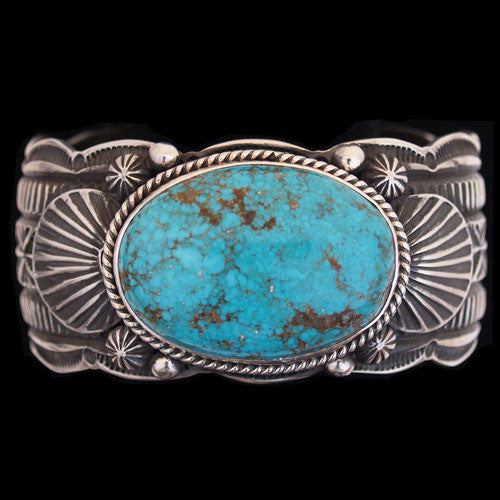
Navajo Burnham Turquoise Bracelet - Guy Haskie (#20)
$1,200.00
Artist: Guy Haskie
Navajo Jewelry
Total Circumference: 6 1/4"
Inner Circumference: 5 1/4"
Opening: 1"
Guy Haskie is known for his deeply precise and precisely deep silver stamping and his choice of topnotch stones. In this bracelet, Guy has placed a monster cabochon of blue-green Burnham turquoise on a hand-stamped shank and brought us a bracelet anyone with an eye for fashion will be proud to own and wear.
We offer a 100% satisfaction guarantee on every purchase.
Related legends:
Precious Stones
Turquoise; Precious stones have symbolic implications. For example, turquoise if a "collective term for all the precious stones, wealth, or mixed offerings. Good fortune is attributed to this stone." Both white shell and turquoise are emphasized in Kinaalda? More about this legend
Certificate of Authenticity

Navajo Burntwater Weaving - Ruth Nelwood (#01)
$3,600.00
Artist: Ruth Nelwood
Navajo Rugs
Burntwater
47" x 35"
Burntwater rugs were created to bring out the best features of the Navajo weaving art. The focus is on fineness of weave, exacting symmetry and a wide ranging palate of pastel colors derived from Navajoland herself. Navajo artist Ruth Nelwood has fashioned a rug worthy of the Burntwater classification. She presents beauty, balance, a superior weave and a soft, delicate sense of the earth and sky through her fiber art. This rug is a portrait of what is fascinating and endearing about the people of the desert Southwest
We offer a 100% satisfaction guarantee on every purchase.
Related legends:
Weaving
After the medicine woman told the people about the prayersticks she told them that there was a place in the underworld where two rivers crossed. It was called ni tqin'kae tsosi, fine fiber cotton (Indian hemp). There were two persons who brought the seed of that plant, they were spiders. They said that the people were to use the plant instead of skins for their clothing. So this seed was planted in the earth? More about this legend
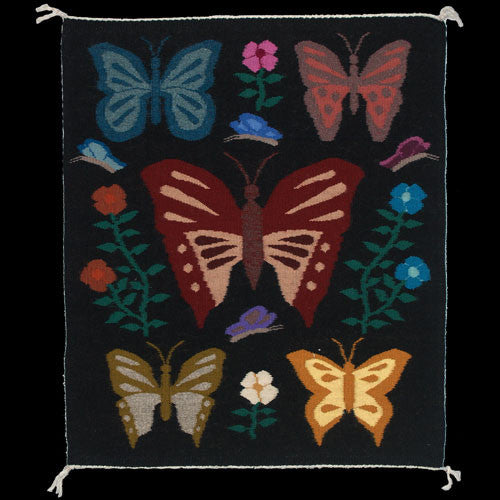
Navajo Butterflies Pictorial Rug - Helena Begay (#67)
$875.00
Artist: Helena Begay
Navajo Rugs
26" x 30 3/4"
Butterflies have inspired artists from every culture. This is certainly the case with Navajo artist Helena Begay. Helena sees the butterfly as a teacher and mentor in the process of progressive awareness and understanding. The "upward moving way" suggests there is much to know and room to grow, and Helena expresses that sentiment through her charming and attractively woven textiles. Grow forth!
We offer a 100% satisfaction guarantee on every purchase.
Related legends:
Butterfly in Navajo Traditional Stories
Butterfly: Due to the natural beauty of its wings, Butterfly is often considered vain. Yet, in Navajo mythology, Butterfly brings the sacred flint to the hooves of the horse. In the legend of the diety, Butterfly Boy was cured of his vanity by being lightning struck with the axe of Rain Boy. After that, his head opened up and out of it came the butterflies of the world. The perishable dust of Butterfly's wings is sometimes thought to prove that such beauty is usually not durable.
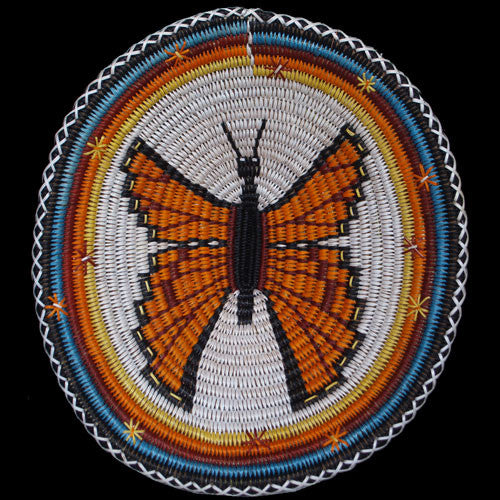
Navajo Butterfly Basket - Elsie Holiday (#406)
$1,875.00
Artist: Elsie Holiday
Navajo Basket
13" x 14 1/2" x 3 1/2" deep
Rounds: 21
Elsie Holiday loves butterflies and also loves to weave baskets. Put these two passions together and this is what you get, a contemporary Navajo basket that knocks your socks off. What a thing of beauty!
We offer a 100% satisfaction guarantee on every purchase.
About the artist:

Considered one of the best Navajo basket weavers, Elsie Stone Holiday married into the famed Douglas Mesa family of weavers. Weaving baskets has become almost an addiction for her. "When I go two or three days without weaving I get anxious to get started again," she says. She weaves 12 hours a day, 5 days a week. "Sometimes I think, 'How long can this last?'", she wistfully states, but for now she is content with her art, finding immense satisfaction in creating premier quality baskets.
Related legends:
Butterfly in Navajo Traditional Stories
Butterfly: Due to the natural beauty of its wings, Butterfly is often considered vain. Yet, in Navajo mythology, Butterfly brings the sacred flint to the hooves of the horse. In the legend of the diety, Butterfly Boy was cured of his vanity by being lightning struck with the axe of Rain Boy. After that, his head opened up and out of it came the butterflies of the world. The perishable dust of Butterfly's wings is sometimes thought to prove that such beauty is usually not durable.
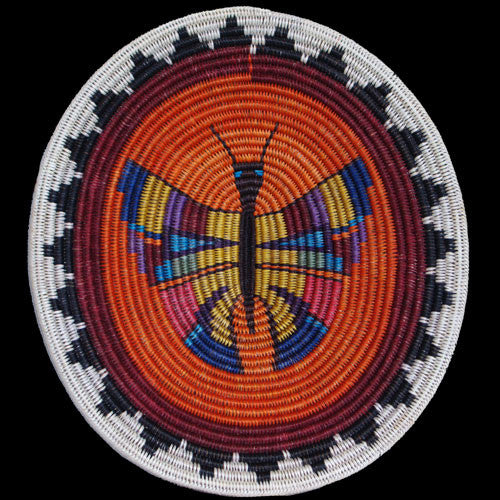
Navajo Butterfly Basket - Elsie Holiday (#412)
$2,750.00
Artist: Elsie Holiday
Navajo Basket
17" x 19" x 3" deep
Rounds: 25
Elsie Holiday started thinking about change earlier this month, and a butterfly basket is what evolved. This wonderful creature in fall colors is nothing less than stunning. Well, what else would we expect from Elsie.
We offer a 100% satisfaction guarantee on every purchase.
About the artist:

Considered one of the best Navajo basket weavers, Elsie Stone Holiday married into the famed Douglas Mesa family of weavers. Weaving baskets has become almost an addiction for her. "When I go two or three days without weaving I get anxious to get started again," she says. She weaves 12 hours a day, 5 days a week. "Sometimes I think, 'How long can this last?'", she wistfully states, but for now she is content with her art, finding immense satisfaction in creating premier quality baskets.
Related legends:
Butterfly in Navajo Traditional Stories
Butterfly: Due to the natural beauty of its wings, Butterfly is often considered vain. Yet, in Navajo mythology, Butterfly brings the sacred flint to the hooves of the horse. In the legend of the diety, Butterfly Boy was cured of his vanity by being lightning struck with the axe of Rain Boy. After that, his head opened up and out of it came the butterflies of the world. The perishable dust of Butterfly's wings is sometimes thought to prove that such beauty is usually not durable.
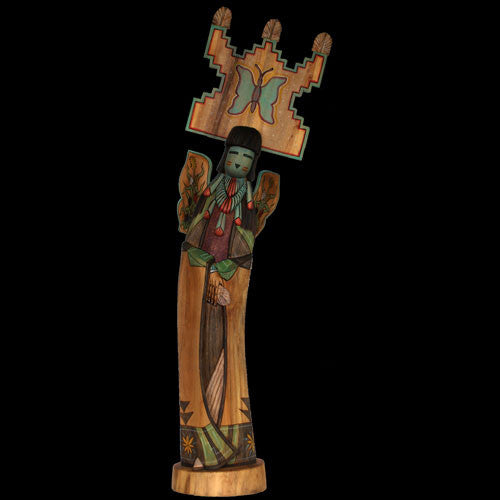
Navajo Butterfly Corn Maiden Cottonwood Carving - Dennis Ross (#70)
$1,100.00
Artist: Dennis Ross
Folk Art
Base: 6" x 4 3/4"
Height: 31"
Dennis Ross inhabits many cultures all at the same time, and his carvings speak not only of interesting art, but also of legends, history and ancient stories. He is half Hopi and Navajo and his art showcases that side of him. In this piece Dennis has taken a branch of dried out cottonwood root, than whittled, sanded, painted, and made a beautiful butterfly sculpture. Adding imagery of corn, fertility, prayer and turquoise; Dennis has done what he always does best; carving things of beauty out of wood.
We offer a 100% satisfaction guarantee on every purchase.
About the artist:

Asked how he first started carving, Dennis Ross answers with a laugh, "My brother - he gave me a knife, and a stone, and a piece of carving wood, and said, 'Here you go'." Dennis was twenty-six years old. His brother, Harry Bert, also gave him a little constructive criticism on that first experiment into the creative world of carving, but Dennis took it from there.
Related legends:
Butterfly in Navajo Traditional Stories
Butterfly: Due to the natural beauty of its wings, Butterfly is often considered vain. Yet, in Navajo mythology, Butterfly brings the sacred flint to the hooves of the horse. In the legend of the diety, Butterfly Boy was cured of his vanity by being lightning struck with the axe of Rain Boy. After that, his head opened up and out of it came the butterflies of the world. The perishable dust of Butterfly's wings is sometimes thought to prove that such beauty is usually not durable.

Navajo Butterfly w/ Brazilian Agete and Fossilized Coral Buckle - Benjamin Piasso (#01)
$599.00
Artist: Benjamin Piasso
Navajo Jewelry
2 1/4" x 2 1/8"
Butterflies are a symbol of change, beauty and a well-lived life. Benjamin Piasso has taken Brazilian agate, black jade and coral and blended them into a super dress belt buckle that will accent any type of dress. Dress yourself up and fly.
We offer a 100% satisfaction guarantee on every purchase.
Related legends:
Silversmith Work
When and how the Navajo acquired the art of working metals is unknown but there are reasons for supposing that it was introduced among them, or at least more developed and improved upon by them, since the time they have occupied their present country?
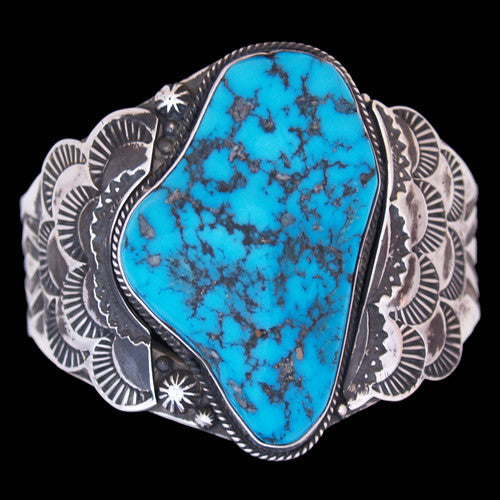
Navajo Castle Dome Turquoise Bracelet - Eugune Livingston (#128)
$3,200.00
Artist: Eugune Livingston
ATC
Navajo Jewelry
Castle Dome Turquoise Bracelet
Size: 6 1/2
In his latest work, Eugene Livingston has revived a 1940s jewelry design, added his own twist of creativity and crafted a very nice wrist cuff. Eugene starts with sterling silver shot, heats it until molten and pours it into a bar. He then puts the bar through a heavy duty roller and mills it to the desired thickness. Using this process he makes his own silver sheet and wire in order to create his unique jewelry pieces. The solidity and strength of Eugene's jewelry allows it to wear better and last longer. This bracelet is set with a high grade, natural cabochon of Castle Dome turquoise from Globe, Arizona.
We offer a 100% satisfaction guarantee on every purchase.
Castle Dome Turquoise
Castle Dome turquoise is derived from the Globe-Miami mining district, Gila County, Arizona, five miles west of Miami. The Castle Dome open-pit copper mine, rests on the south slope of Porphyry Mountain.
Castle Dome Turquoise, CuO·3Al2O3·P2O5·H2O.--is fairly widespread throughout the chalcocite zone and in the leached capping. A hard variety of gem quality occurs in small veinlets up to one-quarter inch thick and also in concretion-like masses up to one-half inch thick and several inches across. Its color ranges from sky-blue to bluish-green, the blue variety predominating. It is generally associated with clay minerals and sericite which form selvages on the veins and masses and are commonly included in the turquoise. Seen under the microscope; it it is a microcrystalline aggregate having a mean index of refraction of 1.62.
A few specimens of a light-green, iron-bearing copper aluminum phosphate were found occurring in the same manner as the hard blue turquoise. It is a microcrystalline aggregate whose mean index of refraction is 1.67. Charles Milton of the Geological Survey identified the mineral as a ferrian turquoise. He reports as follows:
Employees of the mine have been permitted to dig turquoise on days when they were not on duty, and an amazingly large quantity of the mineral has been purchased by dealers in Globe and Miami. Unfortunately no record is available as to the amount of turquoise produced, but undoubtedly the Castle Dome mine is one of the most important sources of gem turquoise at the present time.
Turquoise is generally conceded to be a supergene mineral, formed by the action of ground-water solutions, carrying copper and phosphate ions, on kaolin and possibly sericite. Various writers describe all stages in the alteration from copper-stained kaolin to hard blue turquoise; but it is not usually clear from the published descriptions whether the mineral is kaolinite or some other clay. Kaolinite is not a common mineral in the Castle Dome deposit, and its association with turquoise has not been noted; however, turquoise is commonly associated with beidellite, halloysite, and sericite. No evidence has yet been found suggesting that it forms from clay. The hard blue turquoise grades into the soft, white clay-like variety; but the index of refraction of all of it is near 1.62, which is much higher than that of any of the clays present. None of the material could be construed as being transitional between turquoise and the associated clay.
Although turquoise is most abundant in the upper part of the secondary sulfide zone, it is commonly found in deep fractures where chalcopyrite is only slightly replaced by chalcocite or not at all. If turquoise was formed by supergene solutions, the phosphate ion would have to be derived from either wavellite or apatite which are the only earlier phosphate minerals. Wavellite is apparently dissolved by supergene solutions, but much turquoise occurs in parts of the mine where no wavellite has been recognized. In the Castle-an-Dinas mine in Cornwall,15 wavellite spheres are commonly covered by minute botryoidal aggregates of bright-green turquoise, but no such association has been seen in the Castle Dome deposit. Most writers look to apatite as the probable source of phosphate ion even though admitting in some cases that the country rock contains very little apatite.
American Mineralogist. Volume 63, pages 574-582, PHOSPHATE MINERALS IN THE CASTLE DOME COPPER DEPOSIT, ARIZONA., N.P. Peterson, Abstract
About the artist:

Eugene Livingston - Navajo Jewelry
Eugene is one of those rare artists who has mastered not just one or two methods, but a myriad of jewelry techniques. As a young man, he trained under other talented silversmiths After many decades of steady work, Eugene is skilled at metal fabrication, casting, making his own silver ingots, and most importantly for his work, the ability to cut stones. In his work below, you will see beautiful cut teardrop and pyramid cut Sleeping Beauty turquoise and coral. His two newest pieces with Carico Lake turquoise demonstrate his mastery of silver stamp work.
Related legends:
Silversmith Work
When and how the Navajo acquired the art of working metals is unknown but there are reasons for supposing that it was introduced among them, or at least more developed and improved upon by them, since the time they have occupied their present country?
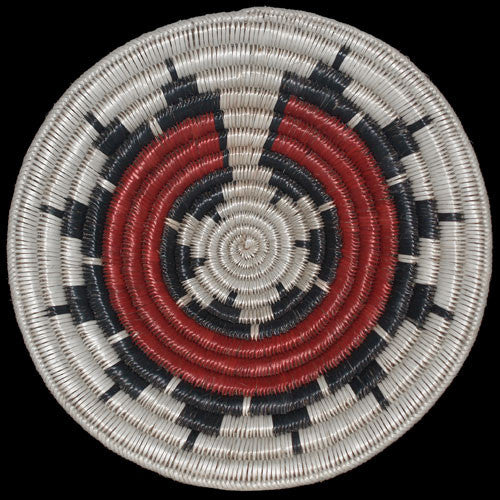
Navajo Ceremonial Basket - Annie Rock (#02)
$375.00
Artist: Annie Rock
Navajo Basket
15" x 1 3/4" deep
Rounds: 15
We offer a 100% satisfaction guarantee on every purchase.
About the artist:

Related legends:
Navajo Ceremonial Baskets
The Navajo wedding basket also reflects many values of traditional life and so often contains all six sacred mountains, including Huerfano and Gobernador Knob, though the size of the basket may determine the numher of mountains in the design. The center spot in the basket represents the beginning of this world, where the Navajo people emerged from a reed? More about this legend
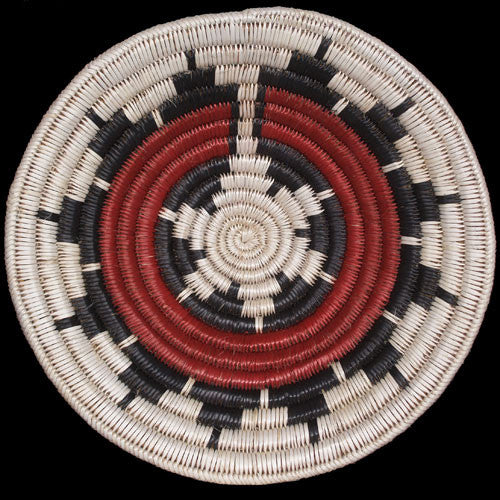
Navajo Ceremonial Basket - Annie Rock (#03)
$375.00
Artist: Annie Rock
Navajo Basket
14" x 2" deep
Rounds: 14
We offer a 100% satisfaction guarantee on every purchase.
About the artist:

Related legends:
Navajo Ceremonial Baskets
The Navajo wedding basket also reflects many values of traditional life and so often contains all six sacred mountains, including Huerfano and Gobernador Knob, though the size of the basket may determine the numher of mountains in the design. The center spot in the basket represents the beginning of this world, where the Navajo people emerged from a reed? More about this legend
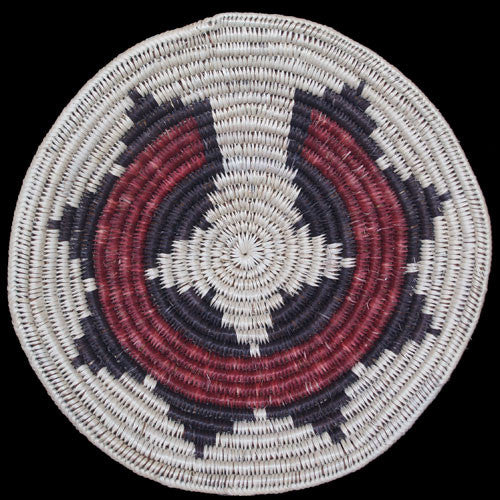
Navajo Ceremonial Basket - Betty Rock Johnson (#119)
$300.00
Artist: Betty Rock Johnson
Navajo Basket
10 1/2" x 2" deep
Rounds: 18
Betty Rock Johnson weaves some of the best Navajo Ceremonial Baskets on the market today. Her baskets are symmetrical, balanced, finely woven and crafted to the highest standards of detailed design. A firm foundation and intricate weave make for a highly collectible basket. Medicine Men and collectors alike battle to get their hands on Betty's baskets. Tradition and culture are found here.
We offer a 100% satisfaction guarantee on every purchase.
About the artist:
 Born and raised on the Eastern edge of Monument Valley, Betty Rock Johnson is a true child of the desert. Raised traditionally in the old way of the Dine ("the people"). She has the look and character of an Elder. The sun, wind, and rain are responsible for the unique character of both the land formations and the furrowed brow and leathery features of its residents. Betty is a product of the elements and shows Mother Earth's handiwork in her eyes and countenance. A basket weaver from a very young age Betty Johnson has perfected her art and creates unique interpretations of her native culture and beliefs. Betty has also produced a number of offspring, she has trained in basket weaving to make it a family affair - an effort the family both enjoys a great deal and relies on to supplement their income. See full biography
Born and raised on the Eastern edge of Monument Valley, Betty Rock Johnson is a true child of the desert. Raised traditionally in the old way of the Dine ("the people"). She has the look and character of an Elder. The sun, wind, and rain are responsible for the unique character of both the land formations and the furrowed brow and leathery features of its residents. Betty is a product of the elements and shows Mother Earth's handiwork in her eyes and countenance. A basket weaver from a very young age Betty Johnson has perfected her art and creates unique interpretations of her native culture and beliefs. Betty has also produced a number of offspring, she has trained in basket weaving to make it a family affair - an effort the family both enjoys a great deal and relies on to supplement their income. See full biography
Related legends:
Navajo Ceremonial Baskets
The Navajo wedding basket also reflects many values of traditional life and so often contains all six sacred mountains, including Huerfano and Gobernador Knob, though the size of the basket may determine the numher of mountains in the design. The center spot in the basket represents the beginning of this world, where the Navajo people emerged from a reed? More about this legend
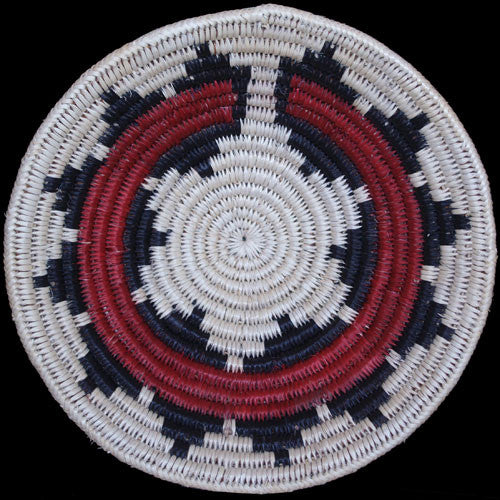
Navajo Ceremonial Basket - Betty Rock Johnson (#120)
$250.00
Artist: Betty Rock Johnson
Navajo Basket
9 1/8" x 2" deep
Rounds: 16
Betty Rock Johnson is related to Joann Johnson, so it's no wonder that she can produce wonderful works of art like this Navajo ceremonial basket. Tight weaves are not something out of nature for Betty. She has a strong hand and it shows in her weave. The traditional ceremonial basket is very useful to the Navajo medicine men. They use the basket to perform ceremonies of marriage between man a woman. The three red rings in the basket represent the coming together of the two humans and the bond that they have with each other. They rings are normally called blood rings in traditional sense.
We offer a 100% satisfaction guarantee on every purchase.
About the artist:
 Born and raised on the Eastern edge of Monument Valley, Betty Rock Johnson is a true child of the desert. Raised traditionally in the old way of the Dine ("the people"). She has the look and character of an Elder. The sun, wind, and rain are responsible for the unique character of both the land formations and the furrowed brow and leathery features of its residents. Betty is a product of the elements and shows Mother Earth's handiwork in her eyes and countenance. A basket weaver from a very young age Betty Johnson has perfected her art and creates unique interpretations of her native culture and beliefs. Betty has also produced a number of offspring, she has trained in basket weaving to make it a family affair - an effort the family both enjoys a great deal and relies on to supplement their income. See full biography
Born and raised on the Eastern edge of Monument Valley, Betty Rock Johnson is a true child of the desert. Raised traditionally in the old way of the Dine ("the people"). She has the look and character of an Elder. The sun, wind, and rain are responsible for the unique character of both the land formations and the furrowed brow and leathery features of its residents. Betty is a product of the elements and shows Mother Earth's handiwork in her eyes and countenance. A basket weaver from a very young age Betty Johnson has perfected her art and creates unique interpretations of her native culture and beliefs. Betty has also produced a number of offspring, she has trained in basket weaving to make it a family affair - an effort the family both enjoys a great deal and relies on to supplement their income. See full biography
Related legends:
Navajo Ceremonial Baskets
The Navajo wedding basket also reflects many values of traditional life and so often contains all six sacred mountains, including Huerfano and Gobernador Knob, though the size of the basket may determine the numher of mountains in the design. The center spot in the basket represents the beginning of this world, where the Navajo people emerged from a reed? More about this legend
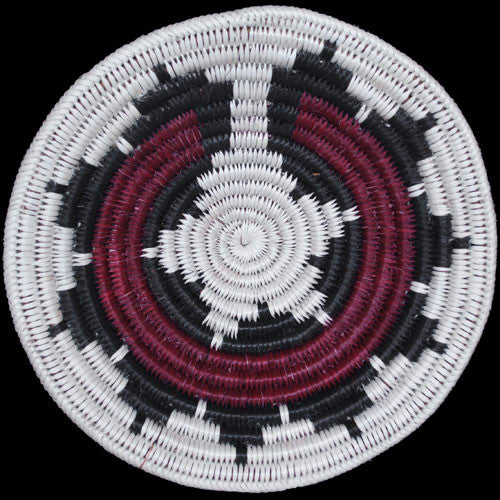
Navajo Ceremonial Basket - Evelyn Cly (#185)
$250.00
Artist: Evelyn Cly
Navajo Basket
10" x 1 1/2" deep
Rounds: 15
We offer a 100% satisfaction guarantee on every purchase.
About the artist:

Evelyn's baskets are known for their extremely tight weave and open geometric designs. Perhaps the best indicator of how valuable her baskets are is that different traders have her baskets in their private collections.
See full biography
Related legends:
Navajo Ceremonial Baskets
The Navajo wedding basket also reflects many values of traditional life and so often contains all six sacred mountains, including Huerfano and Gobernador Knob, though the size of the basket may determine the numher of mountains in the design. The center spot in the basket represents the beginning of this world, where the Navajo people emerged from a reed? More about this legend
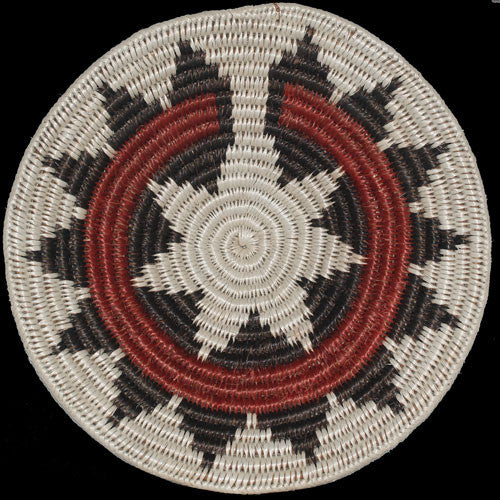
Navajo Ceremonial Basket - Jenny Rock (#02)
$250.00
Artist: Jenny Rock
Navajo Basket
11 1/4" x 1 1/4" deep
Rounds: 18
We offer a 100% satisfaction guarantee on every purchase.
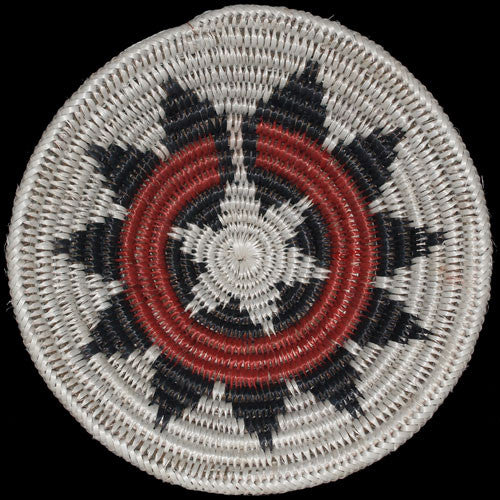
Navajo Ceremonial Basket - Peggy Black (#412)
$250.00
Artist: Peggy Black
Navajo Basket
10" x 1 1/2" deep
Rounds: 16
We offer a 100% satisfaction guarantee on every purchase.
About the artist:
One of the famous Douglas Mesa basket weavers, there wasn't much question about what Peggy Rock Black would choose to pursue in life. She was born into a family of weavers before she married into an equally talented family of weavers.
About the artist:

One of the famous Douglas Mesa basket weavers, there wasn't much question about what Peggy Rock Black would choose to pursue in life. She was born into a family of weavers before she married into an equally talented family of weavers.
Related legends:
Navajo Ceremonial Baskets
The Navajo wedding basket also reflects many values of traditional life and so often contains all six sacred mountains, including Huerfano and Gobernador Knob, though the size of the basket may determine the numher of mountains in the design. The center spot in the basket represents the beginning of this world, where the Navajo people emerged from a reed? More about this legend
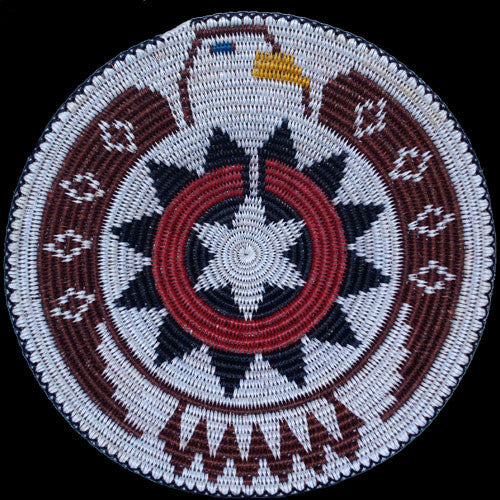
Navajo Ceremonial Eagle Basket - Peggy Black (#411)
$1,875.00
Artist: Peggy Black
16 1/2" x 2 3/4" deep
Rounds: 30
Peggy Rock Black has taken the Navajo ceremonial basket design and embraced it with an eagle motif. The ceremonial pattern is the embodiment of the Navajo universe, and the eagle guards, protects, and is a bridge for communication between humans and the Holy People. On the wings of the eagle are four levels of emergence and duality symbols. In a nutshell Peggy is recognizing the past, present and future of the Navajo people, all upon a woven storyboard.
About the artist:

One of the famous Douglas Mesa basket weavers, there wasn't much question about what Peggy Rock Black would choose to pursue in life. She was born into a family of weavers before she married into an equally talented family of weavers.
Related legends:
Eagle
Of all birds in Native American mythology, the eagle is the most important as symbol, sacrificial / ceremonial presence, and ultimate predator/ warrior. The solitary mystery and power of the eagle as perceived by the Indian was immediately grasped by the emerging nation of the United States, and "borrowed" for its logo. More about this legend
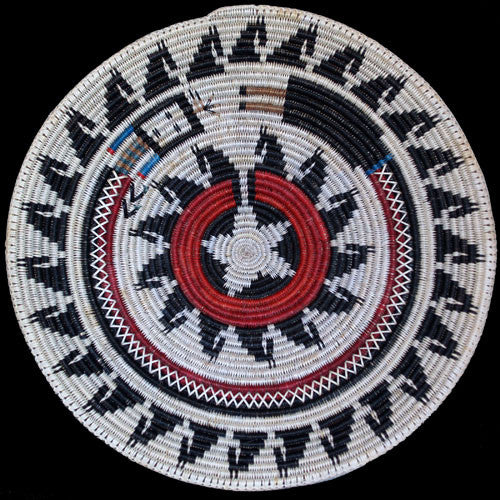
Navajo Ceremonial Horses Yei Basket - Lorraine Black (#247)
$2,750.00
Artist: Lorraine Black
21 1/2" x 3" deep
Rounds: 36
Lorraine Black is Navajo through and through, and her baskets reflect her deep knowledge of the culture. Horses to the Navajo represent a great deal of freedom and mobility, and she has made that clear in this masterpiece. In this representation of a rainbow Yei and his horses, she blends an extraordinary amount of symbolism into a nicely designed and executed basket.
About the artist:

Inspired by dreams, Lorraine Black's skills have literally elevated basket weaving to new dimensions. Lorraine Black's infectious laugh belies the serious magic her hands conjure up when weaving a basket. Unprecedented in her ideas, Lorraine's baskets are innovative and beautiful. Many of them make good use of texture through over-stitching and the addition of objects such as flint arrowheads or horsehair.
Related legends:
Horse
Johano-ai starts each day from his hogan, in the east, and rides across the skies to his hogan in the west, carrying the shining golden disk, the sun. He has five horses a horse of turquoise, a horse of white shell, a horse of pearl shell, a horse of red shell, and a horse of coal? More about this legend
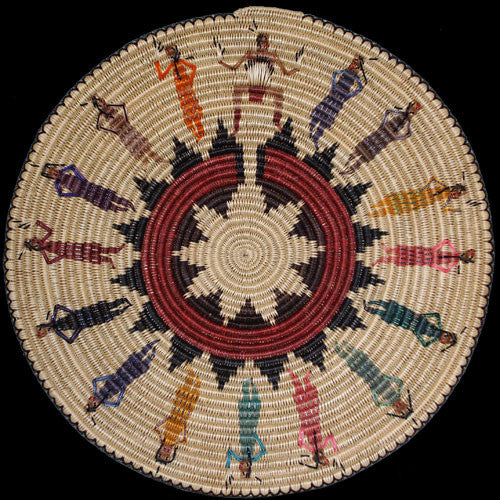
Navajo Ceremonial Jingle Dance Basket - Lorraine Black (#255)
$2,950.00
Artist: Lorraine Black
21" x 2 1/4" deep
Rounds: 32
A pow-wow is a gathering of North America's Native people. The word derives from the Narragansett word powwaw, meaning ‘spiritual leader’. By presenting this woven treasure, Lorraine Black has proven to be a bit of a ‘spiritual leader’ in her own right. At the very least she can be considered a ‘leader of the band’. A modern pow-wow is an event where both Native and non-Native Americans meet to dance, sing, socialize and honor Indian culture. In her basket, Lorraine portrays a ceremonial center representing the Navajo universe and bead-bedecked dancers of various styles circling the world of her people. These guys are giving their all to the occasion—there was fun and merriment had by all!
About the artist:

Inspired by dreams, Lorraine Black's skills have literally elevated basket weaving to new dimensions. Lorraine Black's infectious laugh belies the serious magic her hands conjure up when weaving a basket. Unprecedented in her ideas, Lorraine's baskets are innovative and beautiful. Many of them make good use of texture through over-stitching and the addition of objects such as flint arrowheads or horsehair.
Related legends:
Games/Entertainment
Now it happened in the early days that the night animals wished it were night all the time, and the day animals wished it were day all the time. So they decided to have a game, and the winner of the game would determine whether it would be always day or always night? More about this legend
Certificate of Authenticity
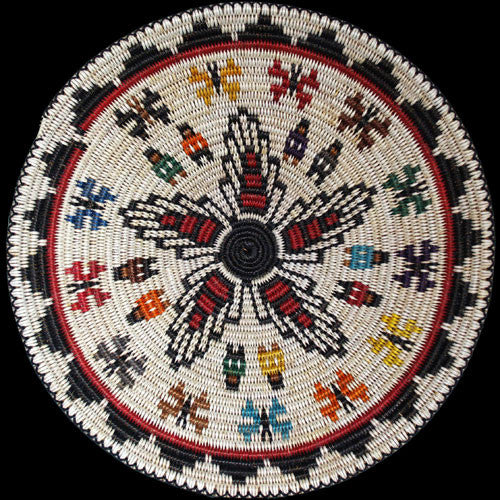
Navajo Ceremonial Squash Blossom Basket - Peggy Black (#385)
$2,750.00
Artist: Peggy Black
Navajo Baskets
21" x 2 1/2" deep
Rounds: 34
Peggy Black likes to mix motifs. In this weaving, she has adorned the traditional ceremonial basket pattern with butterflies, Navajo couples and the five petal squash blossom design. Peggy often refers to these as collage baskets because of this symbolic blending.
We offer a 100% satisfaction guarantee on every purchase.
About the artist:

One of the famous Douglas Mesa basket weavers, there wasn't much question about what Peggy Rock Black would choose to pursue in life. She was born into a family of weavers before she married into an equally talented family of weavers.
Related legends:
Navajo Ceremonial Baskets
The Navajo wedding basket also reflects many values of traditional life and so often contains all six sacred mountains, including Huerfano and Gobernador Knob, though the size of the basket may determine the numher of mountains in the design. The center spot in the basket represents the beginning of this world, where the Navajo people emerged from a reed? More about this legend
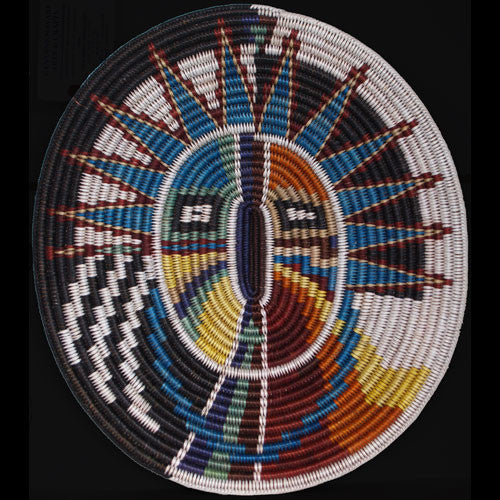
Navajo Changing Woman Basket - Elsie Holiday (#374)
$3,750.00
Artist: Elsie Holiday
Navajo Baskets
16 1/2" x 18 1/2" x 1 1/2" deep
Rounds: 23
The Changing Woman theme has been good to Elsie Holiday. Maybe this is because the divinely depicted goddess is based on totally positive energy. Changing Woman has the resourcefulness to absorb negative energy and redistribute it in a positive manner. Now that would come in handy! Elsie also has the ability to create something visually stimulating from raw vegetation, another gift from Mother Earth. Elsie hopes her depictions of Changing Woman will help others realize the honor and respect our worldly hostess requires to survive.
We offer a 100% satisfaction guarantee on every purchase.
About the artist:

Considered one of the best Navajo basket weavers, Elsie Stone Holiday married into the famed Douglas Mesa family of weavers. Weaving baskets has become almost an addiction for her. "When I go two or three days without weaving I get anxious to get started again," she says. She weaves 12 hours a day, 5 days a week. "Sometimes I think, 'How long can this last?'", she wistfully states, but for now she is content with her art, finding immense satisfaction in creating premier quality baskets.
Related legends:
Navajo Changing Woman
These four visit Changing Woman in her home in the west and see how she changes her age and form as she passes through doors at each of the directions. She decrees her gifts to earth people Cloud, rain, pollen, dew and gives them prayersticks. She tells them that now "there is no meanness left" in her : however First Man and Woman who went east are mean, and from them will come epidemics, colds, and coughs to be cured by offerings of white corn?
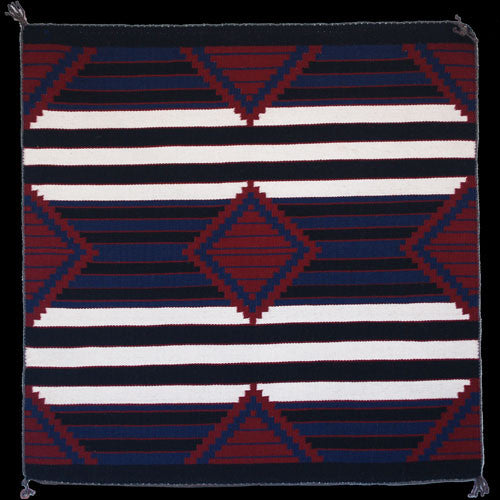
Navajo Chief Revival Rug - Elvie Vanwinkle (#01)
$1,350.00
Artist: Elvie Vanwinkle
24" x 24"
Elvie Van Winkle is an extraordinary rug weaver. Her weave is flawless and her patterns are super crisp and clean. In the good old days, the Chief pattern was the blanket of choice for high-ranking personages of nearby tribes. Everyone who was anyone wanted a Navajo Chief Blanket to express his or her status. Elvie has taken the chief pattern to a much higher level of expertise than most weavers can accomplish. This rug is an excellent example of a classic design with a quality weave.
About the artist:

Related legends:
Chief Rug
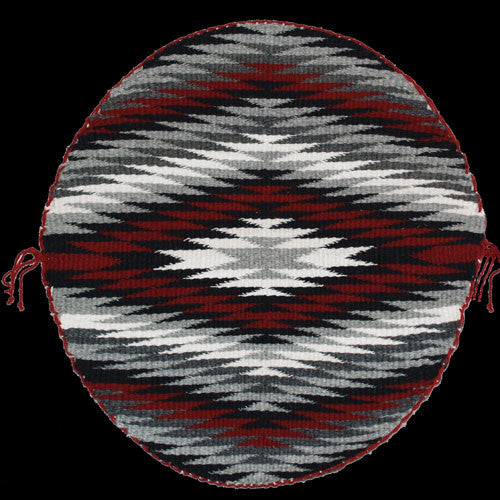
Navajo Circle Eyedazzler Rug - Rolanda Begay (#01)
$330.00
Artist: Rolanda Begay
Navajo Rug
18" x 19"
A round eyedazzler? Now that is rare indeed! Navajo weaver Rolanda Begay is one of the few rug makers to attempt this unusual format, and one of the few to get it right. This rug is a true rounder: full, complete and final.
We offer a 100% satisfaction guarantee on every purchase.
Related legends:
Weaving
After the medicine woman told the people about the prayersticks she told them that there was a place in the underworld where two rivers crossed. It was called ni tqin'kae tsosi, fine fiber cotton (Indian hemp). There were two persons who brought the seed of that plant, they were spiders. They said that the people were to use the plant instead of skins for their clothing. So this seed was planted in the earth? More about this legend
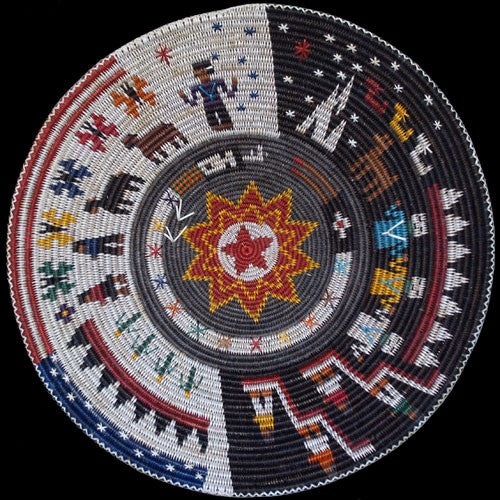
Navajo Collage Basket - Peggy Black (#398)
$4,975.00
Artist: Peggy Black
Navajo Basket
26" x 4 1/2" deep
Rounds: 44
Peggy Rock Black has drawn inspiration from her Native legends and culture to weave a grouping of snapshots within her textural art form. Her "Collage" basket contains images representing legend, life ways, and ceremonialism and Navajo history all packed into one fantastic package. It is significant that Peggy places such important aspects of her people into her baskets in order to spark interest and open a dialogue to those issues on her mind and close to her heart. There are less than one hundred Navajo basket weavers left producing their craft these days and few are in the league of Peggy Rock-Black.
We offer a 100% satisfaction guarantee on every purchase.
About the artist:

One of the famous Douglas Mesa basket weavers, there wasn't much question about what Peggy Rock Black would choose to pursue in life. She was born into a family of weavers before she married into an equally talented family of weavers.
Related legends:
All Animals
After completion of the ceremony the twins return to teach it to earth people and then depart to become guardians respectively of the thunder storm and of animals.
Long Walk
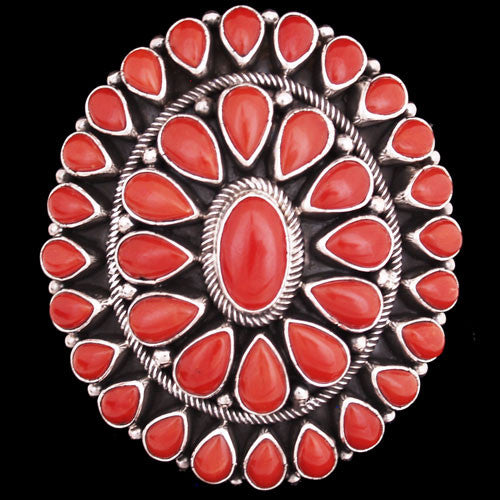
Navajo Coral Cluster Ring - Paul Livingston (#02)
$825.00
Artist: Paul Livingston
Navajo Jewelry
Size: 8
Face: 1 3/4" x 2"
Monumental is the only way to describe this coral ring by Navajo silversmith Paul Livingston. Many people may not have the courage to make a ring of this scale, but Paul does not shrink from such challenges. If you have the heart to wear it, you will surely turn heads.
We offer a 100% satisfaction guarantee on every purchase.
Related legends:
Silversmith Work
When and how the Navajo acquired the art of working metals is unknown but there are reasons for supposing that it was introduced among them, or at least more developed and improved upon by them, since the time they have occupied their present country?

